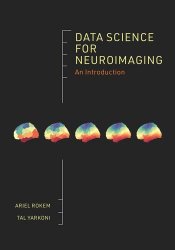 Название: Data Science for Neuroimaging: An Introduction
Название: Data Science for Neuroimaging: An IntroductionАвтор: Ariel Rokem, Tal Yarkoni
Издательство: Princeton University Press
Год: 2024
Страниц: 393
Язык: английский
Формат: pdf (true)
Размер: 12.6 MB
Data Science methods and tools―including programming, data management, visualization, and Machine Learning―and their application to neuroimaging research.
As neuroimaging turns toward data-intensive discovery, researchers in the field must learn to access, manage, and analyze datasets at unprecedented scales. Concerns about reproducibility and increased rigor in reporting of scientific results also demand higher standards of computational practice. This book offers neuroimaging researchers an introduction to Data Science, presenting methods, tools, and approaches that facilitate automated, reproducible, and scalable analysis and understanding of data. Through guided, hands-on explorations of openly available neuroimaging datasets, the book explains such elements of Data Science as programming, data management, visualization, and Machine Learning, and describes their application to neuroimaging. Readers will come away with broadly relevant Data Science skills that they can easily translate to their own questions.
Note that this book is not meant to be a general introduction to programming. We are going to spend some time introducing the reader to programming in the Python programming language (starting in chapter 5; we will also explain specifically why we chose the Python programming language for this book), but for a gentler introduction to programming, we will refer you to other resources. However, we will devote some time to things that are not usually mentioned in books about programming but are crucially important to data science work, such as how to test software and profile its performance, and how to effectively share software with others.
In the next two parts of the book, we will gradually turn towards topics that are more specific to data science in the context of scientific research, and neuroimaging in particular. First, we will introduce some general-purpose scientific computing tools for numerical computing (in chapter 8), data management and exploration (chapter 9), and data visualization (chapter 10). Again, these tools are not neuroimaging-specific, but we will focus in particular on the kinds of tasks that will be useful when working with neuroimaging data. Then, in the next part, we will describe in some detail tools that are specifically implemented for work with neuroimaging dаta: the breadth of applications of Python to neuroimaging data will be introduced in chapter 11. We will go into further depth with the NiBabel software library, which gives users the ability to read, write, and manipulate data from standard neuroimaging file formats in chapter 12 and chapter 13. The last two parts of the book explore in more depth two central applications of Data Science to neuroimaging data. In the first of these (Part V), we will look at image processing, introducing general tools and ideas for understanding image data (in chapter 14), and focusing on tasks that are particularly pertinent for neuroimaging data analysis; namely, image segmentation (in chapter 15) and image registration (in chapter 16). Finally, the last part of the book will provide an introduction to the broad field of Machine Learning (Part VI). Both of these applications are taken from fields that could fill entire textbooks.
There are a few different Python software libraries that visualize data. We will start with a library called Matplotlib. Matplotlib is a large and complex software library, and there are several different application programming interfaces (APIs) that you can use to write your visualizations. However, we strongly believe that there is one that you should almost always use and that gives you the most control over your visualizations. This API defines objects in Python that represent the core elements of the visualization, and allows you to activate different kinds of visualizations and manipulate their attributes through calls to methods of these objects.
• Fills the need for an authoritative resource on Data Science for neuroimaging researchers
• Strong emphasis on programming
• Provides extensive code examples written in the Python programming language
• Draws on openly available neuroimaging datasets for examples
• Written entirely in the Jupyter notebook format, so the code examples can be executed, modified, and re-executed as part of the learning process
Who This Book Is For:
This book was written to introduce researchers and students in a variety of research fields to the intersection of Data Science and neuroimaging.
Скачать Data Science for Neuroimaging: An Introduction